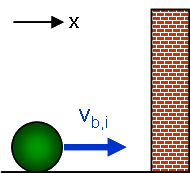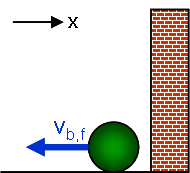Simple problem illustrating the definition of impulse and the utility of an initial-state final-state diagram.
Consider a ball of mass mb that is moving to the right at a constant speed vb when it suddenly impacts a wall and reverses direction (still moving at the same speed). What is the impulse delivered to the ball in the collision?
Solution
System:
The ball as a point particle.
Interactions:
During the impact, we assume that the [collision force] from the wall is vastly larger than any other external forces on the ball, so that other forces are ignored.
Model:
Momentum and External Force.
Approach:
Diagrammatic Representation
The magnitude of the momentum before and after the collsion is the same (mbvb), which can easily lead to the conclusion that there has been no change. Thinking about the situation, however, should quickly convince you that the ball has certainly been acted on by some force, which implies that a change did occur. Carefully drawing the initial-state final-state diagram below (taking special note of the coordinate system) shows the resolution to this difficulty.
|
|
Initial State |
Final State |
|---|
Mathematical Representation
The ball's initial x momentum is positive in our coordinates (+mbvb), while its final x momentum is negative ( – mbvb), giving a change of:
\begin
[ J_
= -m_
v_
- m_
v_
= -2m_
v_
]\end
where the negative sign indicates that the impulse is applied in the negative x direction, and so the impulse points leftward in this case.

